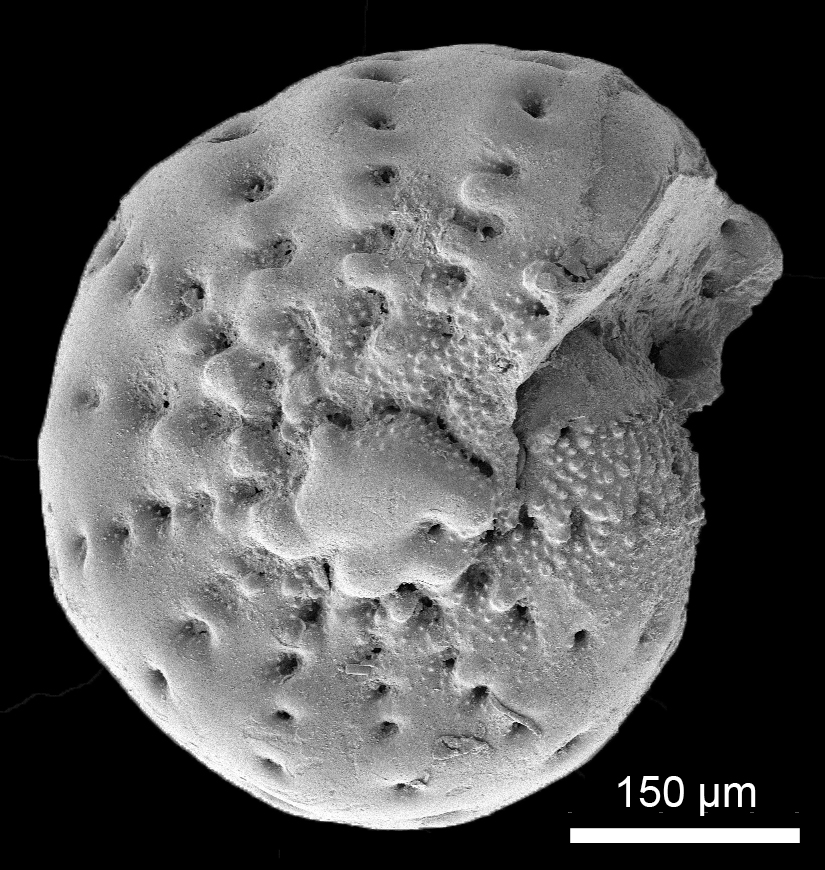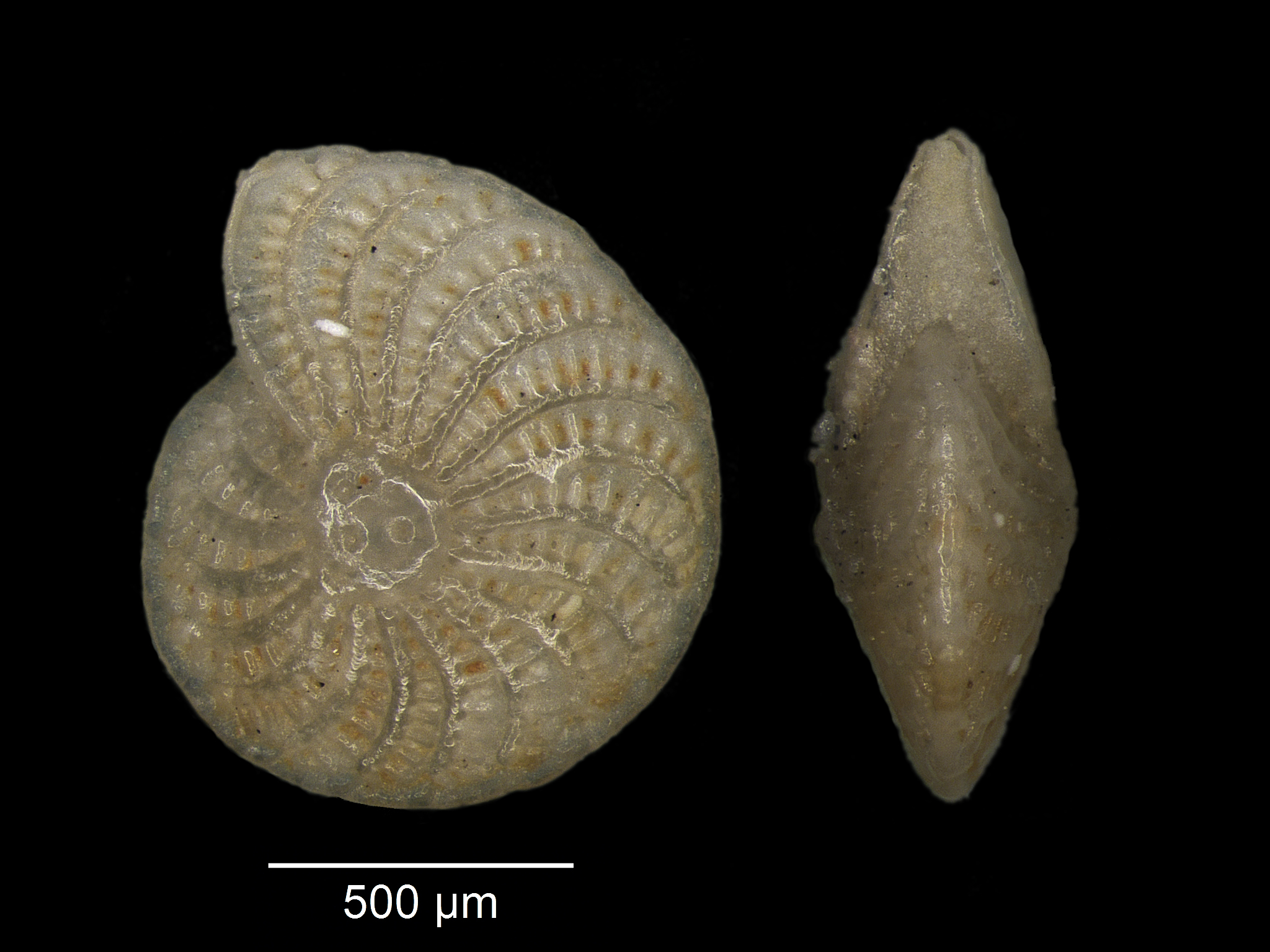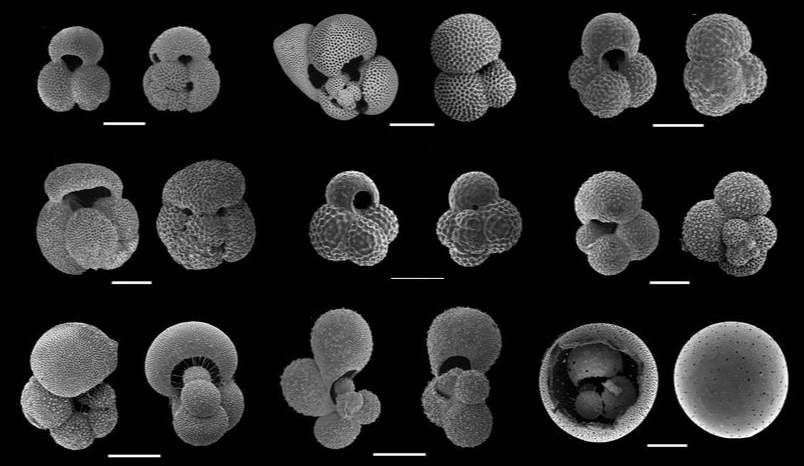
Author: Francesca Bulian – Universidad de Salamanca (Spain)
Oceans are one of the largest and most productive habitats on our planet. Nonetheless most of the living organisms remain invisible to the naked eye: for instance, the Foraminifera (commonly referred as forams). They are single-celled eukaryotic organisms that live in the photic zone (the uppermost portion of the water column sufficiently illuminated to permit photosynthesis) of the marine environment and exhibit floating lifestyles (planktonic foraminifera) or live on the bottom of the water body and on the seafloor (benthic foraminifera). The name “foraminifera” is derived from the Latin word foramen, which means opening, and is referred to the apertures in their shells or tests. The tests are generally made of calcium carbonate (CaCO3) and can have many shapes ranging from spherical, conical and discoidal to a more “pop-corn” globose appearance. They grow chamber-by-chamber to accommodate new cell as the specimen develops, kind of like adding floors or rooms onto a house. Whit a growing number of chambers, they can coil and stuck in a spiral pattern.
Dying Foraminifera, both planktonic and benthic, continuously accumulate on the sea floor and their calcium carbonate tests remain preserved as fossils in the accumulating sediments and for scientists become essential for the understanding of the evolution of Earth’s oceans and climate. Scientists analyse sediments samples taken from the field or from sedimentary cores (like long cylinders) sampled from the sea floor up to hundreds of meters’ depth. The deeper the core goes, the sediments will be older and consequently it will be possible to read further in the past climate. The field samples or samples taken from the core sections are afterwards, being washed and finally when just the foraminifera remain it is possible to proceed with the analyses. Micropaleontologists count at least 300 specimens and classify them into different species and calculate the percentage of each in respect to the total number.

So how is possible that these little invisible creatures tell us so much about the past?
Foraminifera are very sensitive to physical and biological environmental changes and therefore, are ideal indicators for paleogeographic and paleoclimatic history of the Earth. The formation of the tests is affected by the state of marine environment, and therefore can provide data on temperature, salinity, trophic state, pH and CO2 of the water.
Different species of planktonic foraminifera are adapted for living in different climatic conditions and can be grouped into five main assemblages that define the tropical, subtropical, temperate, subpolar, and polar provinces. Furthermore, the distribution and abundance of the species is strongly linked to surface-water properties and its one of the factors which controls the foraminifera assemblages. Sea-surface temperature appears to be one of the most important factors controlling assemblage composition. It becomes clear that knowing the species present in the sediments, it is possible to have an insight on the climatic conditions present in that area in a certain past time frame. This is not all. As all organisms are affected during growth by the state of their physical environment, planktonic foraminifera shells can provide a multitude of information on the past environments based on the chemical composition and morphology. For instance, the morphology can reflect paleo water temperatures; smaller shells are usually associated with colder conditions and coiling direction changes can be also associated with temperature changes. Moreover, foraminiferal calcite reflects the chemistry of the environment water and has been used as a recorder of surface-water composition.
Benthic foraminifera are used as well for unravelling past environments. Because these foraminifera are usually adapted for life at specific depths and water salinity, knowing the species present in the sediments can offer information both on the paleobathimetry present at the time of deposition and also on the environment itself. In this way it is possible to understand what environment was present in a certain moment in the past in the sampling area; if it was a freshwater marsh or a brackish lagoon, or a fully marine deep environment. In this way, in some cases and with the help of modern-day equivalents is possible as well to calculate sea level changes in a certain area. The latter is extremely useful especially nowadays in the global warming perspective and it gives useful information of the actual sea-level fluctuations from the past.
One of the most important applications of both benthic and planktonic forams is that by the measurements of the oxygen isotopes in their shells it is possible to understand in a relatively precise way the paleotemperatures. With the help of this kind of studies scientists become aware of the cyclical alternation of glacial and interglacial conditions which affect our planet. How is the oxygen isotope concentration actually affected by the temperature? Water doesn’t contain just oxygen but different isotopes with different mass. Among the stable isotopes important are the heavy isotope 18O and the light one 16O. Evaporation effects the concentration of these isotopes in sea water and consequently it is reflected in the composition of the foraminifera shells. During colder times it evaporates mostly the lighter isotope and the shells remain enrichen in 18O showing higher values, while during warmer periods the evaporation is strong enough to evaporate the heavier isotope as well leaving the water and the shells with lower 18O quantities.

Finally, because of all the years in which scientists have been studying forams in marine and continental sediment records, it become obvious that certain species appeared and disappear globally, or in a certain area at the same time. This bioevents have been extremely useful to set indirect chronological constrains in areas where other precise dating methods were not possible (i.e. radiocarbon dating).
As you can see these little guys can give us a huge variety of information about our planet and past environments and with time probably new applications will be discovered and that is the reason why scientist continue to study them.
References
Gooday, A.J., Todo, Y., Uematsu, K. and Kitazato, H., 2008. “New organic-walled Foraminifera (Protista) from the ocean’s deepest point, the Challenger Deep (western Pacific Ocean)”. Zoological Journal of the Linnean Society, 153(3), pp.399-423.
Hutchings, D.A., “Planktic Foraminifera”. Geology, 24, pp.115-118.
Kucera, M., 2007. “Chapter six planktonic foraminifera as tracers of past oceanic environments”. Developments in marine geology, 1, pp.213-262.
Pearson, P.N., 2012. “Oxygen isotopes in foraminifera: Overview and historical review”. The Paleontological Society Papers, 18, pp.1-38.
Rossi, V. and Horton, B.P., 2009. “The application of a subtidal foraminifera-based transfer function to reconstruct Holocene paleobathymetry of the Po Delta, northern Adriatic Sea”. The Journal of Foraminiferal Research, 39(3), pp.180-190.
Cover image mofidied from:
Kimoto K. (2015) Planktic Foraminifera. In: Ohtsuka S., Suzaki T., Horiguchi T., Suzuki N., Not F. (eds) Marine Protists. Springer, Tokyo.
